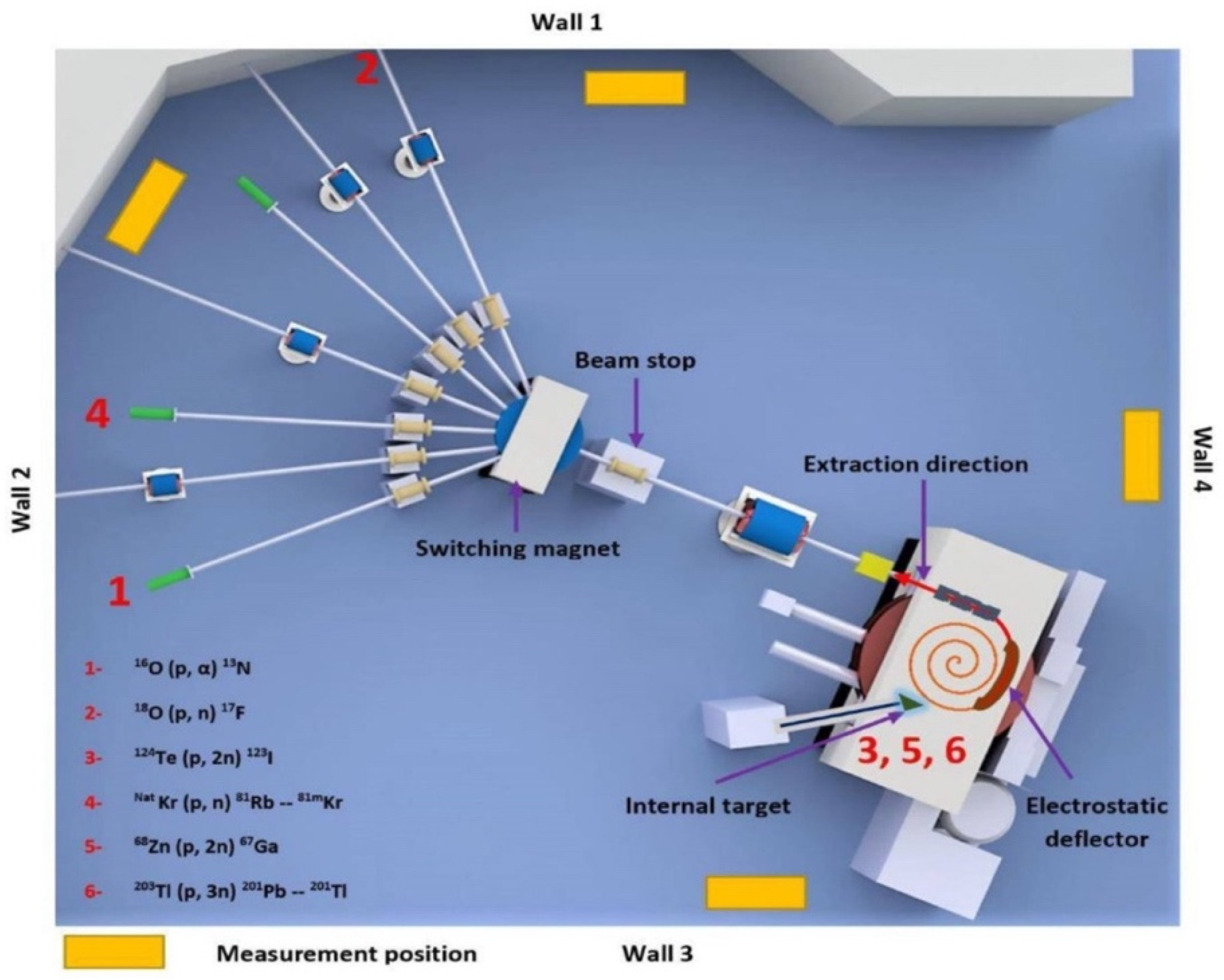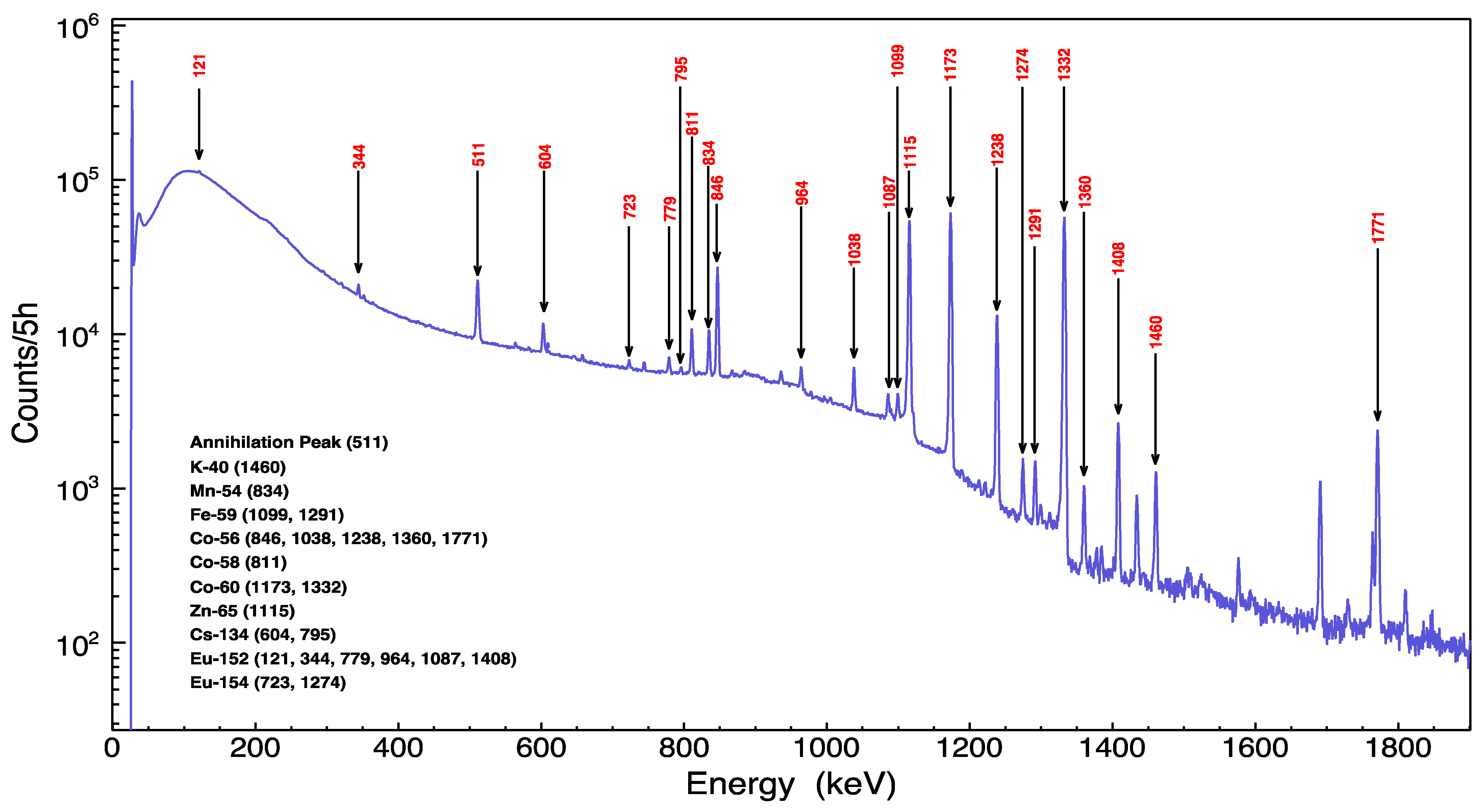Identification of Activation Isotopes in a CS-30 Cyclotron Vault
Abstract
:1. Introduction
2. Materials and Methods
2.1. The CS-30 Cyclotron Facility
2.2. The Geant4 Model
2.3. Gamma Spectroscopy System
3. Results and Discussion
3.1. Activation Radionuclides
3.2. Dose Rates Inside the CS-30 Vault
4. Conclusions
Author Contributions
Funding
Institutional Review Board Statement
Informed Consent Statement
Data Availability Statement
Acknowledgments
Conflicts of Interest
References
- International Atomic Energy Agency (IAEA). Cyclotron Produced Radionuclides: Principles and Practice; IAEA Technical Reports Series No. 465; IAEA: Austria, Vienna, 2009. [Google Scholar]
- International Atomic Energy Agency (IAEA). Cyclotron Produced Radionuclides: Guidelines for Setting Up a Facility; IAEA Technical Reports Series No. 471; IAEA: Austria, Vienna, 2009. [Google Scholar]
- Vallabhajosula, S. Molecular Imaging in Oncology, 1st ed.; Springer: Berlin/Heidelberg, Germany, 2009; pp. 45–56. [Google Scholar]
- Méndez, R.; Iñiguez, M.P.; Martí-Climent, J.M.; Peñuelas, I.; Vega-Carrillo, H.R.; Barquero, R. Study of the neutron field in the vicinity of an unshielded PET cyclotron. Phys. Med. Biol. 2005, 50, 5141–5152. [Google Scholar] [CrossRef] [PubMed]
- Gallerani, R.; Cicoria, G.; Fantuzzi, E.; Marengo, M.; Mostacci, D. Neutron production in the operation of a 16.5 MeV PETrace cyclotron. Prog. Nucl. Energy 2008, 50, 939–943. [Google Scholar] [CrossRef]
- Tripathy, S.P.; Paul, S.; Sahoo, G.S.; Suman, V.; Sunil, C.; Joshi, D.S.; Bandyopadhyay, T. Measurement of fast neutron spectra from the interaction of 20 MeV protons with thick Be and C targets using CR-39 detector. Nucl. Instrum. Methods Phys. Res. B 2014, 318, 237–240. [Google Scholar] [CrossRef]
- Tang, Y.; Li, S.; Yang, Y.; Chen, W.; Wei, H.; Wang, G.; Yang, J.; Liao, J.; Luo, S.; Liu, N. A simple and convenient method for production of 89Zr with high purity. Appl. Radiat. Isot. 2016, 118, 326–330. [Google Scholar] [CrossRef] [PubMed]
- Fernández, F.; Amgarou, K.; Domingo, C.; García, M.J.; Quincoces, G.; Marti-Climent, J.M.; Méndez, R.; Barquero, R. Neutron spectrometry in a PET cyclotron with a Bonner sphere system. Radiat. Prot. Dosim. 2007, 126, 371–375. [Google Scholar] [CrossRef] [PubMed]
- Sarkar, P.K. Neutron dosimetry in the particle accelerator environment. Radiat. Meas. 2010, 45, 1476–1483. [Google Scholar] [CrossRef]
- Masumoto, K.; Toyoda, A.A.; Eda, K.; Izumi, Y.; Shibata, T. Evaluation of radioactivity induced in the accelerator building and its application to decontamination work. J. Radioanal. Nucl. Chem. 2003, 255, 465–469. [Google Scholar] [CrossRef]
- Mukherjee, B. Radiation safety issues relevant to proton therapy and radioisotope production medical cyclotrons. Radiat. Prot. Environ 2012, 35, 126. [Google Scholar] [CrossRef]
- Pelowitz, D.B.; Durkee, J.W.; Elson, J.S.; Fensin, M.L.; Hendricks, J.S.; James, M.R.; Johns, R.C.; McKinney, G.W.; Mashnik, S.G.; Verbeke, J.M.; et al. MCNPX 2.7. 0 Extensions; Report LA-UR-11–02295; Los Alamos National Laboratory: Los Alamos, NM, USA, 2011. [Google Scholar]
- Martínez-Serrano, J.J.; Díez de Los Ríos, A. Prediction of neutron induced radioactivity in the concrete walls of a PET cyclotron vault room with MCNPX. Med. Phys. 2010, 37, 6015–6021. [Google Scholar] [CrossRef] [PubMed]
- Kambali, I.; Suryanto, H.; Parwanto, P. Identification and Angular Distribution of Residual Radionuclides Detected on the Wall of BATAN’s Cyclotron Cave. Atom Indones. 2016, 42, 1. [Google Scholar] [CrossRef]
- Yamaguchi, I.; Kimura, K.I.; Fujibuchi, T.; Takahashi, Y.; Saito, K.; Otake, H. Radiation safety management of residual long-lived radioactivity distributed in an inner concrete wall of a medical cyclotron room. Radiat. Prot. Dosim. 2011, 146, 167–169. [Google Scholar] [CrossRef] [PubMed]
- Fujibuchi, T.; Nohtomi, A.; Baba, S.; Sasaki, M.; Komiya, I.; Umedzu, Y.; Honda, H. Distribution of residual long-lived radioactivity in the inner concrete walls of a compact medical cyclotron vault room. Ann. Nucl. Med. 2015, 29, 84–90. [Google Scholar] [CrossRef] [PubMed]
- Vichi, S.; Zagni, F.; Cicoria, G.; Infantino, A.; Riga, S.; Zeller, M.; Carzaniga, T.S.; Nesteruk, K.P.; Braccini, S.; Marengo, M.; et al. Activation studies of a PET cyclotron bunker. Radiat. Phys. Chem. 2019, 161, 48–54. [Google Scholar] [CrossRef]
- Yoshida, G.; Matsumura, H.; Masumoto, K.; Nakamura, H.; Toyoda, A.; Nobuhara, F.; Iwai, S.; Nishikawa, K.; Hayashi, K.; Ishioka, J.; et al. Investigation into activation of accelerators at various synchrotron radiation facilities in Japan. J. Nucl. Sci. Technol. 2021, 1–12. [Google Scholar] [CrossRef]
- Alrumayan, F.; Shawoo, M.; Vora, M. September. Status report of the cyclotrons C-30, CS-30 and RDS-111 at KFSHRC, Saudi Arabia. In Proceedings of the 20th International Conference on Cyclotrons and their Applications, Vancouver, BC, Canada, 16 September 2013. [Google Scholar]
- IBA. Available online: https://www.iba-radiopharmasolutions.com/sites/default/files/2020–08/cbr_c30_v5_r00.pdf (accessed on 17 March 2022).
- Perkinelmer. Available online: https://resources.perkinelmer.com/lab-solutions/resources/docs/SPC_ELAN9000.pdf (accessed on 17 March 2022).
- Agostinelli, S.; Allison, J.; Amako, K.A.; Apostolakis, J.; Araujo, H.; Arce, P.; Asai, M.; Axen, D.; Banerjee, S.; Barrand, G.J.N.I.; et al. GEANT4—A simulation toolkit. Nucl. Instrum. Methods Phys. Res. A 2003, 506, 250–303. [Google Scholar] [CrossRef] [Green Version]
- Brown, D.A.; Chadwick, M.B.; Capote, R.; Kahler, A.C.; Trkov, A.; Herman, M.W.; Sonzogni, A.A.; Danon, Y.; Carlson, A.D.; Dunn, M.; et al. ENDF/B-VIII. 0: The 8th major release of the nuclear reaction data library with CIELO-project cross sections, new standards and thermal scattering data. Nucl. Data Sheets 2018, 148, 1–142. [Google Scholar] [CrossRef]





| Element | Concentration | Element | Concentration (mg/kg) | Element | Concentration (mg/kg) |
|---|---|---|---|---|---|
| (mg/kg) | |||||
| Li | 12 | As | 17.5 | Fe | 53,139 |
| B | 1383 | Rb | 11.3 | Co | 4.6 |
| Ne | 437 | Nb | 1.6 | Ni | 31.1 |
| Na | 588 | Mo | 7.9 | Cu | 30.4 |
| Mg | 3788 | Ag | 2.2 | Zn | 4586 |
| Al | 2690 | Cd | 0.4 | Ga | 1.6 |
| K | 2326 | Sn | 26.4 | Hf | 0.3 |
| Ca | 152,501 | Xe | 3.9 | Ta | 0.4 |
| V | 18 | Cs | 1 | W | 1.8 |
| Cr | 48 | Eu | 0.1 | Pb | 102.8 |
| Mn | 675 | Yb | 0.12 | U | 0.9 |
| Nuclear Reaction | Average Beam Time per Year (h/Year) | Beam Current (µA) |
|---|---|---|
| 16O (p, α) 13N | 73 | 15 |
| 18O (p, n) 18F | 1300 | 20 |
| 124Te (p, 2n) 123I | 625 | 18 |
| NatKr (p, n) 81Rb -- 81mKr | 390 | 30 |
| 68Zn (p, 2n) 67Ga | 315 | 50 |
| 203Tl (p, 3n) 201Pb -- 201Tl | 520 | 100 |
| Interaction Type | Activation Radionuclide | Nuclear Reaction | Half-Life (Years) | Maximum Neutron Cross-Section |
|---|---|---|---|---|
| Fast neutron interaction | 58Co (1) | 59Co (n, 2n) 58Co | 1.94 × 10−1 | 8.30 × 10−1 b at En = 17 MeV |
| 58Co (2) | 58Ni (n, p) 58Co | 6.40 × 10−1 b at En = 9.5 MeV | ||
| 54Mn | 54Fe (n, p) 54Mn | 8.55 × 10−1 | 5.10 × 10−1 b at En = 10 MeV | |
| 40K | 40Ca (n, p) 40K | 1.28 × 109 | 6.30 × 10−1 b at En = 8 MeV | |
| Thermal neutron interaction | 59Fe | 58Fe (n, γ) 59Fe | 1.22 × 10−1 | 9.21 × 10 b at En = 360 eV |
| 152Eu | 151Eu (n, γ) 152Eu | 1.35 × 101 | 6.76 × 105 b at En = 0.01 meV | |
| 154Eu | 153Eu (n, γ) 154Eu | 8.59 × 100 | 1.86 × 104 b at En = 0.01 meV | |
| 134Cs | 133Cs (n, γ) 134Cs | 2.06 × 100 | 1.58 × 103 b at En = 22.5 eV | |
| 65Zn | 64Zn (n, γ) 65Zn | 6.70 × 10−1 | 5.88 × 10 b at En = 281 eV | |
| 60Co | 59Co (n, γ) 60Co | 5.27 × 100 | 1.87 × 103 b at En = 0.01 meV | |
| Proton interaction | 56Co | 56Fe (p, n) 56Co | 2.11 × 10−1 | - |
Publisher’s Note: MDPI stays neutral with regard to jurisdictional claims in published maps and institutional affiliations. |
© 2022 by the authors. Licensee MDPI, Basel, Switzerland. This article is an open access article distributed under the terms and conditions of the Creative Commons Attribution (CC BY) license (https://creativecommons.org/licenses/by/4.0/).
Share and Cite
Abuhoza, A.A.; Kassim, H.A.; Alghamdi, A.A.; Alrumayan, F.M.; Arib, M.; Aljammaz, I.J.; ALQahtani, M. Identification of Activation Isotopes in a CS-30 Cyclotron Vault. Sensors 2022, 22, 2581. https://doi.org/10.3390/s22072581
Abuhoza AA, Kassim HA, Alghamdi AA, Alrumayan FM, Arib M, Aljammaz IJ, ALQahtani M. Identification of Activation Isotopes in a CS-30 Cyclotron Vault. Sensors. 2022; 22(7):2581. https://doi.org/10.3390/s22072581
Chicago/Turabian StyleAbuhoza, Alhussain A., Hamoud A. Kassim, Ahmed A. Alghamdi, Faisal M. Alrumayan, Mehenna Arib, Ibrahim J. Aljammaz, and Meshari ALQahtani. 2022. "Identification of Activation Isotopes in a CS-30 Cyclotron Vault" Sensors 22, no. 7: 2581. https://doi.org/10.3390/s22072581
APA StyleAbuhoza, A. A., Kassim, H. A., Alghamdi, A. A., Alrumayan, F. M., Arib, M., Aljammaz, I. J., & ALQahtani, M. (2022). Identification of Activation Isotopes in a CS-30 Cyclotron Vault. Sensors, 22(7), 2581. https://doi.org/10.3390/s22072581






